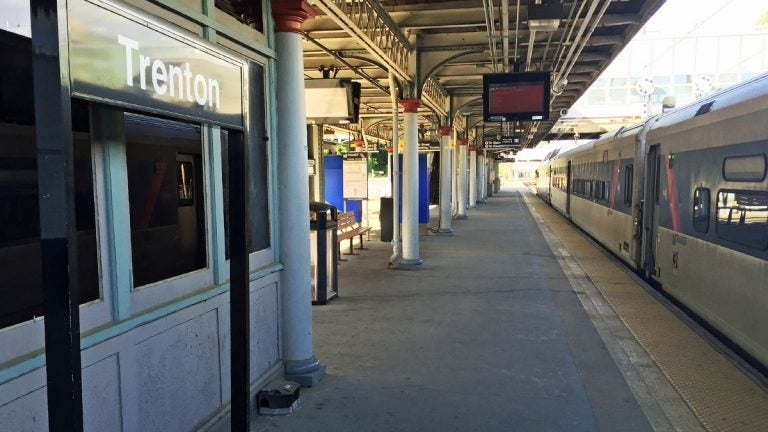Rail advocates say NJ Transit needs more state money to keep it safe

An NJ Transit train sits at the station in Trenton
New Jersey Transit train riders who suspect their daily commutes are riddled with more service failures than their counterparts in other states aren’t imagining it. On average, NJ Transit train cars break down 12 times more often than commuter rails serving other metro regions, and an NJT train travels just 118,000 miles before breaking down. Long Island Rail Road trains, by comparison, fail once every 700,000 miles.
Saying that NJT is on a financial “path to destruction” that prevents it from conducting even routine maintenance, rail engineering experts told Trenton lawmakers that the agency is having trouble making a massive, federally required safety upgrade because its funding formula relies too much on unpredictable ticket sales instead of dedicated funding from the state.
“A generation of neglect … is coming home to roost,” Doug O’Malley from Environment New Jersey told members of the Senate Legislative Oversight and Assembly Judiciary committees Tuesday.
The committees called representatives from Environment New Jersey, American Public Transit Association (APTA), Tri-State Transportation Campaign, and Amtrak to testify in the third of at least five hearings on the NJ Transit user experience and its progress in meeting a December 31, 2018 federal deadline to install Positive Train Control (PTC) on its locomotives. PTC is a system that matches train speed to track conditions and can override an engineer to automatically slow or stop a train before it crashes. Though PTC systems vary, most or all detect train location, direction and speed through communications between an onboard computer and wayside and base-station radios along the route.
All of the nation’s passenger trains and freight rail systems that carry certain types of hazardous materials have been pushing hard to implement PTC since Congress mandated use of the relatively new technology in 2008. The National Transportation Safety Board hasn’t yet issued any formal conclusions about whether PTC could have stopped an NJ Transit train from speeding into the Hoboken Terminal in September, killing one woman, though it has determined that it would have prevented an Amtrak derailment in Philadelphia that killed eight and injured 185 last spring.
But as Amtrak’s top PTC manager George Hartman testified, the challenges of implementing the signal system are enormous. Amtrak activated PTC on lines it owns on the Northeast Corridor (between Boston and Washington, D.C.) and from Philadelphia to Harrisburg about a year ago. But most of the nation’s 26 commuter rail agencies are scrambling. At an earlier hearing, NJT board chairman Richard Hammer told committee members that his agency is on track to meet the 2018 deadline, and APTA’s Carolyn Hayward-Williams backed up his claim by saying New Jersey’s progress falls in line with most of its peers. Only 19 percent of the agencies, she adds, will bring PTC online by the end of this year. However, the fact that NJT has only recently secured the required radio frequency and has done no installations leaves lawmakers skeptical about meeting the deadline and dubious about why New Jersey still has so far to go.
“It sounds like we have a lack of funding, lack of effort, ineptitude, and an inability to get people trained,” said Senate Legislative Oversight Chair Robert Gordon (D-Fair Lawn) during the hearing. “New Jersey Transit’s problems run much deeper than its failure to implement PTC on a timely basis.”
According to Janna Chernetz of the Tri-State Transportation Campaign, he’s right.
In fiscal 2009, the state gave NJT $348 million in direct subsidies. In fiscal 2017, direct subsidies totaled $140 million, which marked a huge increase over fiscal year 2016. This means that NJT gets just 1.3 percent of its operating budget from the state and 57 percent from passenger fares. In Los Angeles, those percentages are practically flipped, with 57 percent of revenue coming from the state and 22 percent from riders.
What’s more, NJT has raised fares five times since 2000 yet still receives more fines than any other railroad for safety violations and suffers disproportionately from frequent staff turnover, difficulty filling key positions, and a crash rate that’s higher than the nation’s 10 largest commuter rail operators.
But the real problem, as it relates to maintenance and PTC, are capital to operating transfers. NJT has transferred $7 billion from its capital budget to its operations budget since 1990 — a move that translates into a 16 percent drop in capital spending between 2002 and 2017 despite ridership climbing 23 percent during approximately the same period.
“New Jersey Transit is an outlier in how we fund operations,” said Chernetz. “Others use dedicated money. They don’t have to go through the political process year in and year out and hope they get enough money.”
That’s not to say that other agencies, like the Chicago Transit Authority and the Southeastern Pennsylvania Public Transit Authority (SEPTA) that services Philadelphia, haven’t depended on transfers at times. But Chernetz says both acknowledged the practice and celebrated when they moved away from the stop-gap model.
“Acknowledging it is crucial to fixing it, and that’s something NJ Transit has not done,” she said. “Capital fund transfers since 2005 have pretty much eaten up every dollar that goes into the capital budget from the Transportation Trust Fund. This is unsustainable and won’t allow NJ Transit to be reliable, safe, and affordable.”
Speakers were able to trace a direct line between NJT’s raided capital fund and any sluggishness the transit agency may bring to the PTC project. Because this federal mandate is unfunded, the first stage in everyone’s game was to find money. SEPTA, for example, was able to quickly gather funding and purchase the radio frequency needed for communications from the Federal Communications Commission (FCC) before most. This set it on an early course to completion, as agencies that waited longer have had to bid against one another to buy their bandwidth from the FCC or from private concerns who bought it up as soon as Congress passed the mandate. In a normal year, the FCC receives around 25 purchase applications. Year one of the mandate, applications jumped up to 25,000.
Train systems are also competing against one another for design, manufacturing, and installation services as well as workers trained to do repairs. The technology’s only been in use since 1999 so there aren’t enough firms yet to handle the spike in demand and there aren’t enough people who’ve done the four-year coursework required to become a maintenance worker. The 24/7, 365-day-a-year schedule makes it difficult to recruit young employees who have the luxury of shopping around for the highest salary before accepting a position that will likely force them to spend the better part of a decade working the third shift with Tuesdays and Wednesdays off.
And with the tight timeframe (the original deadline for implementation was the end of 2015), Hartman said, “We were designing, testing, and implementing at the same time. Anybody who’s ever built anything knows that’s the worst thing you can do. You never do your R&D after you’ve done your installation.”
Despite that, Amtrak has been able to speed ahead of the metro lines for several reasons. Perhaps most notably is the fact that the type of PTC it’s using to maintain compatibility with the Northeast and Mid-Atlantic metro systems that travel over its lines works most efficiently when it doesn’t have to be programmed to measure track conditions and speed limits on numerous curves and bridges and other reasons to stop or slow down. Unlike the metro lines, Amtrak doesn’t have the crossings, branches, turns, and short distances between stations that have to be accounted for. Whereas Amtrak spent $100 million on the Northeast and Philadelphia-Harrisburg routes, SEPTA and NJ Transit have each spent in the neighborhood of $250 million. That said, Amtrak did work on the northern portion of the Northeast Corridor first because the route between New York and Boston is much straighter than the one between New York and Washington, D.C.
Another issue is where to locate the radio towers to carry the signals. Amtrak has a lot of range to place its towers where they won’t interfere with height, depth, historical, and environmental restrictions.
While lawmakers and the governor work to solve the state’s transportation funding crisis, a congressional delegation from New Jersey has asked the federal Department of Transportation to approve a $10 million grant to help the rail agency pay for PTC.
Members of the same delegation announced Tuesday that in response to the deadly Conrail derailment and chemical spill in Paulsboro in 2012, railroads have voluntarily agreed to follow federal government safety protocols instead of insisting on their own.
_________________________________________________________________
NJ Spotlight, an independent online news service on issues critical to New Jersey, makes its in-depth reporting available to NewsWorks.
WHYY is your source for fact-based, in-depth journalism and information. As a nonprofit organization, we rely on financial support from readers like you. Please give today.




